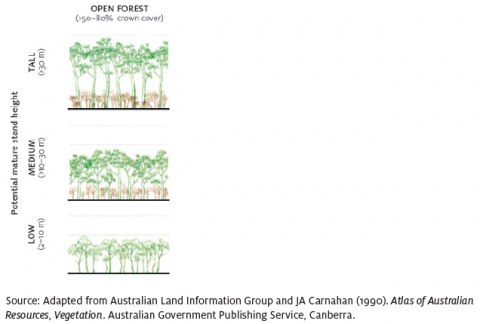Australia’s forests and forestry glossary
Old-growth forest
Ecologically mature forest where the effects of past disturbances are now negligible.
See Ecologically mature, Mature, Senescent.
Open forest
As a National Forest Inventory cover class, forest in which the tree crowns cover from over 50% to 80% of the land area.
See Closed forest, Crown cover, National Forest Inventory, Woodland forest.

Click here for an enlarged version.
Other Crown land
Crown land reserved for a variety of purposes, including utilities, scientific research, education, stock routes, mining, water-supply catchments, and use by Indigenous communities. Excludes leasehold forest, nature conservation reserve, and multiple-use public forest.
One of six land tenure classes used to classify land in the National Forest Inventory.
Other forest
A National Forest Inventory forest category that principally comprises non-commercial plantations and planted forests that are not reported through the National Plantation Inventory but that satisfy the definition of forest.
‘Other forest’ includes agroforestry plantations, sandalwood plantations, environmental plantings, plantations within the reserve system, and plantations regarded as not commercially viable. Non-planted forests dominated by introduced species are also included in this category.
‘Other forest’ does not include forest reported in the other two national forest categories, ‘Commercial plantation’ and ‘Native forest’.
See Agroforestry, Commercial plantation, Environmental planting, Forest, Introduced species, National Forest Inventory, Native forest, Plantation, Sandalwood.
Other log products
Low-quality sawlogs, girders, poles, piles, wood used in mines, split and round posts, bush sawn/hewn timber and sleepers, fuelwood logs and firewood, and other logs that are not sawlogs (including sliced veneer sawlogs) or pulplogs. This category can also include other log types if not included elsewhere, such as peeled veneer logs.
Differs from the category ‘Other wood products’ in including fuelwood logs and firewood.
See Other wood products.
Other native forest
As a national native forest type used by the National Forest Inventory, one of several types of forest of minor extent such as those dominated by trees of the genera Agonis, Atalaya, Banksia, Hakea, Grevillea, Heterodendron, Leptospermum, Lophostemon or Syncarpia, as well as native forests where the type is unknown.
See Commercial plantation, National Forest Inventory, Native forest, Native forest type.
Other special rights
A National Forest Inventory category of land or forest subject to Native Title determinations, registered Indigenous Land Use Agreements and legislated special cultural use provisions. Independent of tenure, these can provide Indigenous peoples and communities with the right to access areas of cultural significance, use areas for cultural purposes, or be consulted before major development activities.
See Indigenous co-managed (of land or forest), Indigenous managed (of land or forest), Indigenous owned (of land or forest), National Forest Inventory.
Other wood products
Low-quality sawlogs, girders, poles, piles, wood used in mines, split and round posts, bush sawn/hewn timber and sleepers, and other logs that are not sawlogs (including sliced veneer sawlogs) or pulplogs, but not fuelwood logs or firewood. This category can also include other log types if not included elsewhere, such as peeled veneer logs.
Differs from the category ‘Other log products’ in excluding fuelwood logs and firewood.
See Other log products.
Other woody vegetation
Outrow
A row of trees felled in a plantation, including to allow travel of machinery.
Over-mature
See Senescent.
Overstorey
1. The uppermost layer of foliage in a forest.
2. Trees occupying the uppermost layer in a forest of more than one layer (storey).
